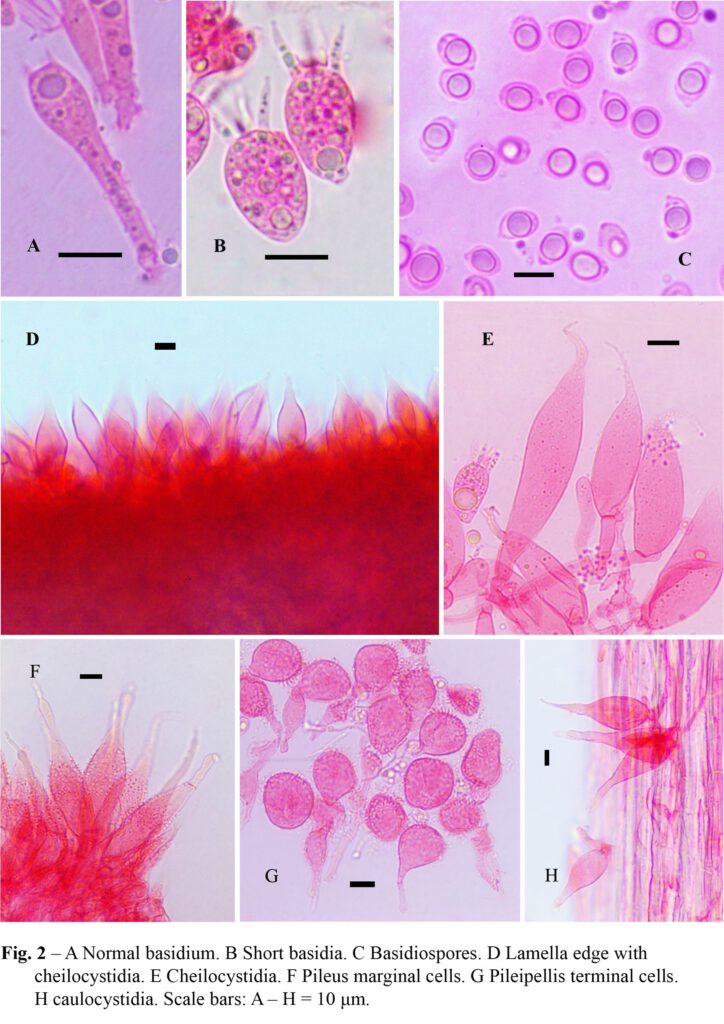Mycena chlorophos (Berk. & M.A. Curtis) Sacc.
MycoBank number: MB 147895; Index Fungorum number: IF 147895; Facesoffungi number: FoF 10625;
Description
Pileus 3–25 mm diam., parabolic to spherical in buds, becoming convex to plano-convex with a shallow depression at centre when mature; surface dark blonde to grayish brown (5D4/6F6/6F8/8D3) uniformly in buds becoming pure white with grayish or brownish disc when mature, pellucid striate, viscid with a thick gluten cover in wet weather, glabrous, shiny; disc become oak brown to mustard brown (4D6/5E4–5E6) in dry weather with paler margin, striate, sticky; margin straight, crenate. Lamellae adnexed, (rarely with a pseudocollarium) white, up to 4 mm wide, close with lamellulae of 1–3 lengths; edge concolorous to the sides, entire. Stipe 5–20 × 0.5–20 mm, central, terete, cylindric, curved, equal arising from a cupulate basal disc, narrowly hollow; surface transparent white except at the extreme base which is pale grayish, smooth, glabrous, non-viscid. Odor mild, not characteristic. Spore print off white to cream. Basidiospores 6–10 × 4–6.8 μm (Lm=7.72, Wm=5.66); Q=1.06–1.69; Qm = 1.36, ellipsoid, smooth, amyloid, thin-walled, hyaline. Basidia are of two types: normal basidia less abundant, 26–36 × 6–8 μm, 4-sterigmate, clavate, thin-walled, hyaline; short, subglobose to vesiculose clavate basidia 16.8–22 × 12–16 μm, abundant, 4-sterigmate, sterigmata up to 13 μm long. Lamella edge sterile, non-gelatinised. Cheilocystidia abundant, 28–68 × 5.6–20 μm, fusoid-ventricose, narrowly to broadly fusiform, broadly lageniform, apically narrowed to a long thin, simple, whip like extension, smooth, hyaline, thin-walled. Pleurocystidia absent. Pileipellis an ixotrichoderm, up to 145 μm thick, composed of repent, radially arranged, widely spaced hyphae, 2.4–3.2 μm diam., cylindrical, thin, highly branched, coralloid with clavate, broadly clavate to globose terminal cells 14.4–36.8 × 96–20.8 μm, densely spinulose, or with needle like out growths, embedded in a gelatinous matrix, hyaline, inamyloid, thin-walled. Pileus marginal cells abundant, 48–92 × 11–20 μm, fusoid to fusoid-ventricose, with a long whip like apex, moderately spinulose over the central part, elsewhere smooth, hyaline, thin-walled. Stipitipellis a cutis of repent hyphae with scattered to clustered caulocystidia, almost similar to cheilocystidia in shape, 30–144 × 11–24 μm, fusoid to fusoid-ventricose. Clamp connections common in all tissues. Luminescence – Pileus and hymenophore emitting bright, greenish light in the dark; luminescence not observed in other parts of the basidiomata.
Material examined: India, Kerala State, Thiruvananthapuram District, Palode, JNTBGRI campus, 22 Jul 2019, TBGT(M)17871; ibid., 24 Jul 2019, TBGT(M)17887; ibid., 13 Aug 2019, TBGT(M)17926; ibid., 05 Sep 2019, TBGT(M)17957; ibid., 16 Oct 2019, TBGT(M)17993; ibid., 24 Oct 2019, TBGT(M)17999; 25 Oct 2019, TBGT(M)18002; 21 May 2020, TBGT(M)18075; 22 May 2020, TBGT(M)18078; ibid., 23 May 2020, TBGT(M) 18080; ibid., 25 May 2020, TBGT(M)18084; ibid., 01 Jun 2020, TBGT(M)18088, ibid., 04 Jun 2020, TBGT(M)18093; ibid., 05 Jun 2020, TBGT(M)18094; ibid., 08 Jun 2020, TBGT(M)18095; ibid., 09 Jun 2020, TBGT(M)18100; ibid., 10 Jun 2020, TBGT(M)18104; ibid., 08 Jul 2020, TBGT(M)18151; ibid., 09 Jul 2020, TBGT(M)18161; ibid., 03 Aug 2020, TBGT(M)18218; ibid., 05 Aug 2020, TBGT(M)18232.
Distribution: Solitary to scattered on dead, decaying bamboo culms (Ochlandra tavancorica) in tropical evergreen forest in Kerala State, India. May – October. Other reports include Malaysia, Japan, Sri Lanka, Borneo, Papua New Guinea, Australia and Brazil
Sequence data: ITS: MZ389977 (ITS1/ITS4).
Notes: Mycena chlorophos was initially described from Bonin Islands in 1860, Japan and later reported from both Old World and New World and hence currently considered as pantropical in distribution (Desjardin et al. 2010). Thus, the report of M. chlorophos from India is significant phytogeographically.

